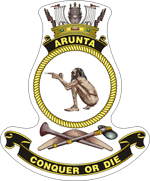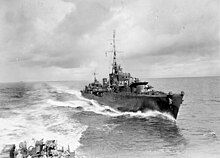
HMAS Napier (G97/D13) was an N-class destroyer serving in the Royal Australian Navy (RAN) during World War II. Built during 1939 and 1940, the destroyer was commissioned into the RAN, although she was ordered and owned by the British government. During 1941, Napier operated in the Mediterranean, before being transferred to the British Eastern Fleet at the start of 1942, then to south Atlantic operations in early 1944. In 1945, Napier was assigned to the British Pacific Fleet, and spent the rest of World War II in the fight against Japan. After the war's end, the destroyer was decommissioned and returned to the British. She was sold off in 1955, and broken up in 1956.

HMAS Nizam (G38/D15) was an N-class destroyer of the Royal Australian Navy (RAN). The destroyer, named after Osman Ali Khan, the last Nizam of Hyderabad, was commissioned into the RAN in 1940, although the ship remained the property of the Royal Navy for her entire career.

HMAS Quadrant (G11/D11/F01), named for the navigational instrument, was a Q-class destroyer operated by the Royal Navy as HMS Quadrant (G67/D17) during World War II, and the Royal Australian Navy (RAN) from 1945 to 1957. The ship was built during the early 1940s as one of the War Emergency Programme destroyers, and entered service in 1942.

HMAS Quiberon (G81/D20/D281/F03) was a Q-class destroyer of the Royal Australian Navy (RAN). Although built for the Royal Navy and remaining British property until 1950, Quiberon was one of two Q-class destroyers commissioned into the RAN during World War II. She was passed into full RAN ownership in 1950, and converted into an anti-submarine frigate.

HMAS Quickmatch (G92/D21/D292/F04) was a Q-class destroyer operated by the Royal Australian Navy (RAN). Although commissioned into the RAN in 1942, the ship was initially the property of the Royal Navy. Quickmatch served with both the British Eastern Fleet and British Pacific Fleet during World War II. In the 1950s, the destroyer was converted into an anti-submarine frigate. In 1957, Quickmatch operated in support of Malaya during the Malayan Emergency. The ship remained in service until 1963, and after use as an accommodation ship, was sold for scrap in 1972.

HMAS Kalgoorlie (J192/B245/A119), named for the city of Kalgoorlie, was one of 60 Bathurst-class corvettes constructed during World War II and one of 20 built for the Admiralty but manned by personnel of and commissioned into the Royal Australian Navy (RAN).

HNLMS Tromp was the lead ship of the Tromp-class destroyer leaders built for the Royal Netherlands Navy. Built just prior to World War II, the ship served mainly in the Pacific and Indian Oceans against the Japanese, being based out of Sydney, Fremantle and Trincomalee where she served alongside British, Australian and US warships. After the war, she returned to the Netherlands; after 1949,Tromp was used as a training and accommodation ship, before being decommissioned in 1955, and scrapped in 1969.

HMAS Swan (U74/F74/A427), named for the Swan River, was a Grimsby-class sloop of the Royal Australian Navy (RAN) that served during World War II.

HMAS Hobart was a modified Leander-class light cruiser which served in the Royal Australian Navy (RAN) during World War II. Originally constructed for the Royal Navy as HMS Apollo, the ship entered service in 1936, and was sold to Australia two years later. During the war, Hobart was involved in the evacuation of British Somaliland in 1940, fought at the Battle of the Coral Sea and supported the amphibious landings at Guadalcanal and Tulagi in 1942. She was torpedoed by a Japanese submarine in 1943, then returned to service in 1945 and supported the landings at Tarakan, Wewak, Brunei, and Balikpapan. Hobart was placed in reserve in 1947, but plans to modernise her and return her to service as an aircraft carrier escort, training ship, or guided missile ship were not followed through. The cruiser was sold for scrapping in 1962.

HMAS Australia (I84/D84/C01) was a County-class heavy cruiser of the Royal Australian Navy (RAN). One of two Kent-subclass ships ordered for the RAN in 1924, Australia was laid down in Scotland in 1925, and entered service in 1928. Apart from an exchange deployment to the Mediterranean from 1934 to 1936, during which she became involved in the planned British response to the Abyssinia Crisis, Australia operated in local and South-West Pacific waters until World War II began.
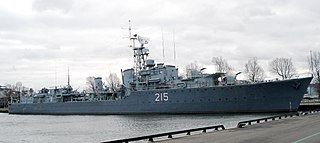
The Tribal class, or Afridi class, was a class of destroyers built for the Royal Navy, Royal Canadian Navy and Royal Australian Navy that saw service in World War II. Originally conceived during design studies for a light fleet cruiser, the Tribals evolved into fast, powerful destroyers, with greater emphasis on guns over torpedoes than previous destroyers, in response to new designs by Japan, Italy, and Germany. The Tribals were well admired by their crews and the public when they were in service due to their power, often becoming symbols of prestige while in service.
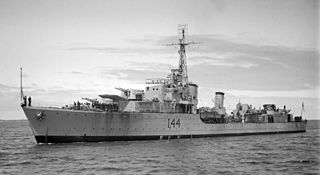
HMAS Warramunga (I44/D123) was a Tribal-class destroyer of the Royal Australian Navy (RAN). Built during World War II, the destroyer entered service in late 1942. She was initially assigned to convoy escort duties, but was assigned to the joint Australian-American Task Force 74 in 1943, and was involved in supporting numerous amphibious landings through the South-east Asian region until the end of the war. From 1950 and 1952, Warramunga fought in the Korean War, then was converted into an anti-submarine destroyer. Returning to service in 1954, the destroyer was one of the first RAN ships to operate with the Far East Strategic Reserve, and undertook two tours with the organisation before she was decommissioned in 1959 and sold for ship breaking in 1963.

HMAS Canberra (I33/D33), named after the Australian capital city of Canberra, was a Royal Australian Navy (RAN) heavy cruiser of the Kent sub-class of County-class cruisers. Constructed in Scotland during the mid-1920s, the ship was commissioned in 1928, and spent the first part of her career primarily operating in Australian waters, with some deployments to the China Station.

HMAS Norman (G49/D16) was an N-class destroyer operated by the Royal Australian Navy (RAN) during World War II. Entering service in 1941, the ship was on loan from the Royal Navy.

The first HMAS Bendigo (J187/B237/A111) was a Bathurst-class minesweeper, a group commonly known as corvettes and including escort and patrol duties along with minesweeping.

HMAS Voyager (D31/I31) was a W-class destroyer of the Royal Navy (RN) and Royal Australian Navy (RAN). Commissioned into the RN in 1918, the destroyer remained in RN service until 1933, when she was transferred to the RAN. Recommissioned, Voyager served in the Mediterranean and Pacific theatres of World War II until 23 September 1942, when she ran aground while trying to deliver troops to Timor. The ship was damaged by Japanese bombers while trying to refloat, then was scuttled by her crew.

SS 's Jacob Dutch freighter built by Maatschappij Fijenoord, Rotterdam, Netherlands, in 1907, of 2,839 GRT and operated by Koninklijke Paketvaart-Maatschappij (KPM) in the Dutch East Indies trade. The ship, after seeking refuge in Australia during the Japanese invasion of the islands, became part of the Southwest Pacific Area (SWPA) command's permanent local fleet. 's Jacob was sunk off Papua New Guinea on 8 March 1943 during World War II by Japanese air attack.

Operation Lilliput was the name given to a convoy operation directed by G.H.Q. Operations Instructions Number 21 of 20 October 1942 for transportation of troops, weapons, and supplies in a regular transport service between Milne Bay and Oro Bay, New Guinea between 18 December 1942 and June 1943 in order "to cover reinforcement, supply, and development of the Buna-Gona area upon its anticipated capture" by the Australian 7th Division and the United States Army's 32d Division. Within six months, the convoys, escorted by Royal Australian Navy corvettes and largely composed of Dutch KPM merchant ships, had delivered 60,000 tons of supplies and 3,802 troops from Milne Bay to Oro Bay. Corvettes provided the majority of the escort force. Losses during Imperial Japanese air attacks amounted to two merchant ships, 's Jacob and Van Heemskerk, sunk and two badly damaged while several of the corvettes also sustained damage and casualties.

The MV Anshun was a 3,188 GRT motor vessel built by Scotts Shipbuilding and Engineering Company Limited, Greenock in 1930 for The China Navigation Company for the Chinese coastal passenger service.
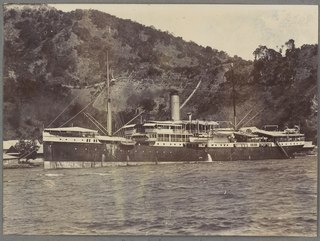
SS Van Heemskerk was a freighter built by N.V. Nederlandsche Scheepsbouw-Maatschappij with engines built by Nederlandsche Fabriek van Werktuigen & Spoorwegmaterieel N.V, both of Amsterdam, Netherlands. The ship of 2,996 GRT was launched 31 August 1909 and delivered 29 October 1909 for operation by Koninklijke Paketvaart-Maatschappij (KPM) in the Dutch East Indies trade.

